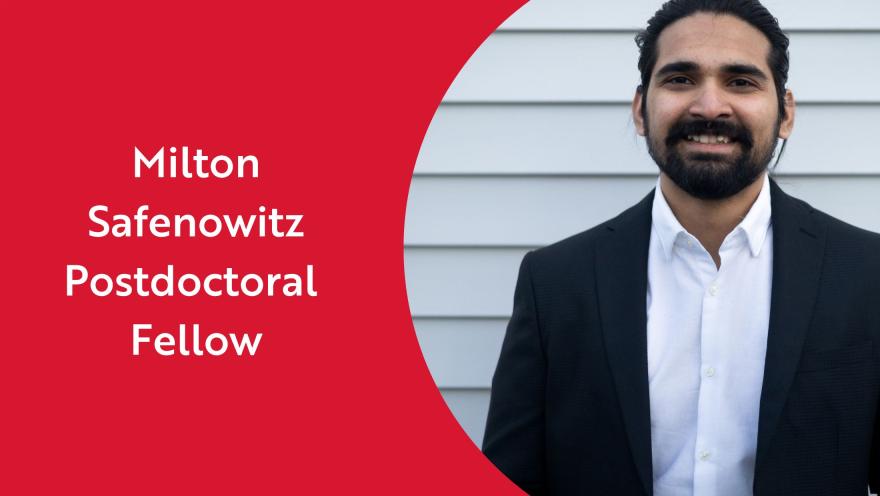To find new treatments and a cure for ALS, it’s vital to have a dedicated network of scientists working to advance our understanding of the disease and thinking creatively about solutions.
We are proud to support the development of bright, young researchers – and their innovative ideas – through our Milton Safenowitz Postdoctoral Fellowship Program. Established in memory of Milton Safenowitz by the Safenowitz family, this unique program encourages young scientists to enter and, importantly, remain in the ALS field. After completing this fellowship, more than 75% of awardees stay in ALS research. Many go on to establish their own laboratories and mentor more ALS researchers along the way.
During the 2022 funding cycle, five new Safenowitz fellows were selected from a highly competitive applicant pool, including Dr. Jayakrishna Shenoy, a postdoctoral research associate at Brown University. We talked with him to learn more about his research, as well as his interests outside the lab.
What made you want to focus on ALS research?
I became interested in neurodegenerative disease research while doing a summer project in Dr. Vinesh Vijayan’s lab at the Indian Institute of Science Education and Research Thiruvananthapuram. His lab was using an advanced structural biology tool called NMR spectroscopy to complete structural studies of the tau protein that is associated with Alzheimer's disease. Working in his lab gave me an introduction to protein aggregation in various neurogenerative diseases, including TDP-43 and ALS. Later on, I did my master's thesis in his lab on structural studies using NMR of a protein called ubiquitin, which is also involved in neurodegeneration and ALS.
This experience motivated me to pursue a Ph.D. in structural studies of TDP-43 and amyloid aggregates using solid-state NMR at the University of Bordeaux, France, under the guidance of Dr. Antoine Loquet and Dr. Birgit Habenstein. During my Ph.D., I was convinced that preventing TDP-43 aggregation could be the key to avoiding or curing ALS and associated diseases. So, I decided to continue my research career by joining Dr. Nick Fawzi’s lab at Brown University. Together, we are working toward developing a therapeutic intervention for ALS by considering TDP-43 as a potential therapeutic target and providing essential information about TDP-43 structure, dynamics and molecular interactions.
What are the goals of your funded research project?
Neuronal deposits or aggregates of the essential human protein TDP-43 are a key feature in 97% of people living with ALS. TDP-43 performs most of its functions in dynamic cellular granules formed by liquid-liquid phase separation, a process in which biomolecules separate from their surroundings like drops of oil in water to perform a specific biological function. Aberrant contacts formed by TDP-43 while in this phase-separated state are considered a potential pathway for aggregation and disease. However, the underlying mechanism of TDP-43 phase separation and aggregation remains elusive.
My project will use integrated experimental and computational structural biology techniques, combined with molecular and cell biology approaches, to get minutely detailed structural information about TDP-43 phase separation and its transition into aggregation.
How might your work impact the ALS community?
The lack of atomic resolution structural information on TDP-43 phase separation and its transition into aggregation hinders the development of an effective treatment for TDP-43-related diseases, including ALS. My project will provide essential structural and dynamic information about TDP-43 that could be used to help guide the development of new strategies to treat and prevent ALS.
What role will this fellowship play in your research efforts?
This fellowship will support the challenging project, provide me with exposure to the ALS research community and enable collaborative efforts to attain the common goal of developing effective therapeutic strategies to cure and prevent ALS.
What do you like most about working in the ALS research field?
The ALS research community is a fantastic group of people, including doctors and scientists with expertise in different scientific backgrounds, working toward the common goal of making the world a better place.
What gives you hope that there will one day be a world without ALS?
In the past few decades, there has been a significant leap in science and technology, including artificial intelligence and gene editing, and in our understanding of how life works at the molecular level. The pandemic has taught us the importance of science and working in harmony, and it gives me hope that collective scientific and technological advances will make life better for everyone.
What do you like to do outside of the lab?
Outside the lab, I enjoy time with friends, watching movies and football, and playing video games.
Is there anything else you’d like to add?
I sincerely thank The ALS Association and Safenowitz family for supporting my research proposal. I feel honored, and it gives me immense confidence as an early-stage researcher that I will make an impact in future breakthroughs and treatments.
If you would like to receive monthly ALS research updates, SUBSCRIBE to our newsletter, Research Matters.
To continue to follow stories about people living with ALS in the community and learn more about the disease, subscribe to receive our weekly blogs in your inbox HERE or follow us at als.org/blog.


Join the conversation. Please comment below.